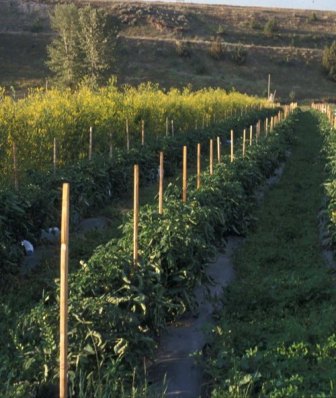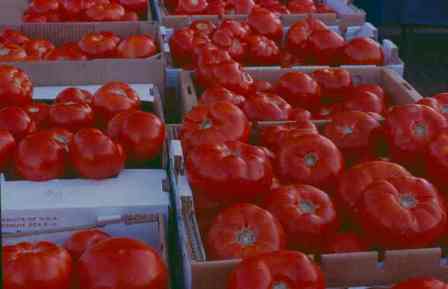

Soil management is at the root of all good farming systems - literally! Organic residue (decomposing plant or animal manure) management is the cornerstone of organic soil management. However, farmers and researchers disagree about what organic residue management methods are best. There is also debate about tillage. Though a traditional weed management method among organic producers, tillage is increasingly implicated in soil health destruction.
When we disturb natural ecosystems to produce crops, soil organic matter levels and microbial populations decrease. In grassland soils, huge drops (from 9 percent down to 4 percent soil organic matter) have been recorded during the first years following tillage. Once soils have been brought into cultivation, exposed bare soil between crop plants and between cropping seasons (winter fallow) creates a nutrient leak. This means leaching or loss of nutrients (like nitrogen)that were continually recycled by the permanent plant cover before cultivation. Addition of organic residues helps overcome some negative effects of tillage on soil health. However, in a California study, tillage and weed cultivation reduced soil organic matter on an Organic farm when compared to an unfarmed grassland, even when lots organic residue from winter cover crops and composts was added.
On my organic vegetable farm, I designed a system that more closely mimics undisturbed ecosystems. My minimum-tillage / living mulch system reduces tillage and maintains soil cover to help close nutrient cycles.

Additions of mowed legume living mulch becomes my fertilizer. Results from my farm concur with other studies: In general, soil management techniques that provide permanent soil cover result in higher microorganism populations and potentially available nitrogen, as well as lower levels of late fall and early spring NO3-nitrogen The type of nitrogen that is easily leached from the soil into groundwater. However, lower levels of early spring nitrogen can mean later and reduced warm season crop yield. In 2003 Biodesign farm overcame potential soil nitrogen deficiencies in cool spring permanent cover soils by incorporating soil warming techniques, such as plastic mulch. In 2007 and 2008 we experimented with raised beds without black plastic to warm soils. Yields were not as early or as high without the black plastic mulch, but they were acceptable.
One of the most important lessons learned over the past 11 years on my farm is that organic residues are not all the same. Some reports indicate that when nitrogen-fixing legumes are used in rotations less than 25% of the time (i.e. only grown 1 in every 4 years), then soil organic matter decreases over a 10-year period. Other researchers found that total amount of residue input alone did not account for changes in soil carbon and nitrogen. They report that plant species composition and litter quality plays an important role in soil organic matter increases and decreases. Biodesign farm has found differences in carbon:nitrogen ratios and macro- and micro-nutrient levels provided by a clover living mulch mowed at different times of the season (spring vs. summer vs. fall). 
The minimum tillage / living mulch system also decreases time spent controlling insects and diseases. Tillage diminishes the habitat of many organisms beneficial to soil and crop health, including earthworms, spiders, insects, and soil microorganisms . Undisturbed, perennial grass habitats provide stable microclimates for beetles and spiders and improve their overwintering success. Beetle banks, areas of raised ground created on agricultural borders where mixed perennial grasses are sown, increased predator carabid beetle populations within cropping systems. Unfortunately, there was no correlative decrease in pest populations with increasing predator beetle populations, except in areas of the cropping system that were closest to the perennial-grass-covered beetle banks. To create a safe haven for predators, I designed permanent plant cover into my cropping system, not just on the edge of the field, but between every crop row. There is no bare soil.

Parasitoid populations also increase with soil cover, diversity, and reduced tillage. Parasitic wasps and flies lay eggs in crop pests and their young feed on the pest after hatching, a little like invasion of the body-snatchers. Populations of fly and wasp parasitoids increase in more diverse habitats that provide season-long pollen and nectar sources.
 The availability of season-long parasitoid food plants translates into higher parasitism rates. The proximity of pollen and nectar plants to crops and their pests affects parasitism rates. In general, as for predators, the closer, the better. There is also evidence that providing habitat for native bees within cropping systems can significantly enhance crop pollination and hence yield. That can translate to more and earlier tomatoes!
The availability of season-long parasitoid food plants translates into higher parasitism rates. The proximity of pollen and nectar plants to crops and their pests affects parasitism rates. In general, as for predators, the closer, the better. There is also evidence that providing habitat for native bees within cropping systems can significantly enhance crop pollination and hence yield. That can translate to more and earlier tomatoes!

Permanent soil cover and reduced tillage have also been associated with enhanced disease suppression. In several studies, undisturbed leguminous under-story cover crops resulted in lower levels of Phytophthora root rot and fusarium wilt. Bacterial Spot of radish was significantly reduced in no-till compared to cultivated plots. Pythium root rot suppression was compared in undisturbed and cultivated soils. Undisturbed soils were 82 percent Pythium suppressive. Newly cultivated soils were only 31 percent suppressive. In soils that had been intensely cultivated for annual cropping over an extended period, Pythium suppression dropped to only 7 percent. However, in some non-organic no-till grain production systems, increased disease has been reported. These no-till grain systems utilize significant amounts of only one kind of plant residue addition, wheat straw.
Weed management has changed, but not necessarily improved in the minimum till / living mulch system. I spend very little time weeding, but mow between rows every 3-4 weeks. Most annual weeds have disappeared, but they have been replaced by one or two weeds that act as biennials and fit well into the reduced tillage/mowing system. I have been forced to become a weed ecologist to manage these weeds.
Please visit with me at the permaculture forums.